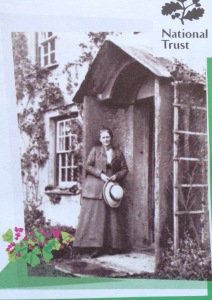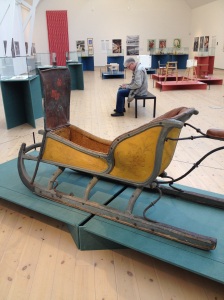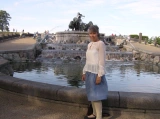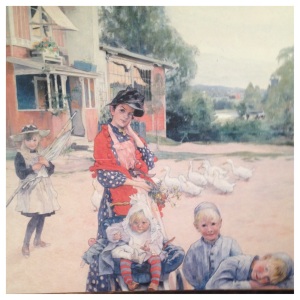Why Finnish Babies Sleep in a Cardboard box?
Link to original article from B.B.C. on Why Finnish babies sleep in a cardboard box?
For 75 years, Finland’s expectant mothers have been given a box by the state. It’s like a starter kit of clothes, sheets and toys that can even be used as a bed. And some say it helped Finland make one of the world’s lowest infant mortality rates.
It’s a tradition that dates back to the 1930s and it’s designed to give all children in Finland, no matter what background they’re from, an equal start in life.
.
The maternity package – a gift from the government – is available to all expectant mothers
It has bodysuits, a sleeping bag, outdoor gear, bathing products for the baby, as well as diapers bedding and a small mattress.
With the mattress in the bottom, the box becomes a baby’s first bed. Many children, from all social backgrounds, have their first naps within the safety
of the box’s cardboard walls.
A 1947 maternity packMothers have a choice between taking the box, or a cash grant, now set at 140 euros, but 95% opt for the box as it’s worth much more.
The tradition dates back to 1938. To begin with, the scheme was only available to families on low incomes, but that changed in 1949.
“Not only was it offered to all mothers-to-be but new legislation meant to get the grant, or maternity box, they had to visit a doctor or municipal pre-natal clinic before their fourth month of pregnancy,” says Heidi Liesivesi, who works at Kela – the Social Insurance Institution of Finland.
So the box provided mothers with what they needed to look after their baby, but it also helped steer pregnant women into the arms of the doctors and nurses of Finland’s nascent welfare state.
In the 1930s Finland was a poor country and infant mortality was high – 65 out of 1,000 babies died. But the figures improved rapidly in the decades that followed.
Mika Gissler, a professor at the National Institute for Health and Welfare in Helsinki, gives several reasons for this – the maternity box and pre-natal care for all women in the 1940s, followed in the 60s by a national health insurance system and the central hospital network.
In Denmark, we did something similar from the thirties and onwards just without giving out a box like the Finnish. Nurses specialised on children were educated to visit all homes just after the baby was born to support breastfeeding and healthy living and in safe surroundings. A kind of schooling for parents in their own homes. None of the visits was compulsory, but as it became so accepted very few ever declined the offer. Included was some prenatal check-ups at the family doctor and the midwife preparing for the birth.
It is all free for everybody. I enjoyed doing this job for more than thirty years.
In an exhibition on circulation here in Scandinavia called “The century of the child” these pictures can be seen. It describes how things began to be created for children in a new scale as the death rate went down and families could start to expect their children to LIVE!
If you would like to read a blog post from a Finnish mother who really appreciates the box, it’s here.
http://helsinkidragonfly.blogspot.se/2016/04/finnish-maternity-package.html?m=1

Beatrix Potter at her house in the Lake District
Children´s books, play parks, furniture and functional clothes were made. The idea that families took the responsibility to make the children a priority is clearly seen in Carl Larsson’s beautiful scenes from his home in Sweden.

The original Carl Larsson’s Sleigh at the exhibition in Sweden





















What an interesting and practical solution to a terrible problem.
LikeLiked by 1 person
I have a Finnish friend and I have asked her about what people think of receiving the boxes. She has four children herself and many grandchildren. I hope she will answer me. At the wartime people were very poor and the Soviet Union put a big pressure on the country during the Cold War. Now they are better off
LikeLike
My generation in Finland was poor indeed. This is true. Thank you for this great post. Happy weekend!
LikeLiked by 1 person
Thank you so much for reading and commenting. I would like to know how parents in Finland regard this gift nowadays
LikeLike
If I understand correct, many appreciate it. Well, I am too old to…
LikeLiked by 1 person
It is a lovely idea to provide a box for the new babies. I love your pictures, the old photos as well as the Beatrix Potter drawings. It’s a good job that I’m too old to get clucky!!
LikeLiked by 1 person
Me too Maddy
LikeLike
What a great idea! Love the photos too….
LikeLiked by 1 person
Thank you Stevie. I had lost “all” my photos so its been a big job to restore the older posts so I felt like posting them again
LikeLike
Thanks for taking the time to post this on the Senior Salon.
LikeLike
Thank you for letting us have this chance to share our writings
LikeLike
I’ve known about this for a while and I think it’s an awesome thing for parents. I showed my daughter and she said, “They actually put their babies in a box?!” That’s pretty much all the space they need anyway. If only we’d have something like that in this country. I love this idea. 🙂
LikeLiked by 1 person
I am waiting for some answers to my questions to my Finnish friend through many years on how this function in real life. I suppose this box was used more in former days as a baby bed. But a new mattress is recommended for each baby and can be moved from the box to a proper bed.
LikeLiked by 1 person
I like it because it promotes a simple approach to parenting. I think baby showers tend to go over the top and most things received as gifts probably never even get used. I’m not saying that babies shouldn’t have quality stuff ~ of course they should ~ but I think there should be more consideration for what necessary and what isn’t. Decorating a nursery is nice if you can do it, but it’s only temporary and has to be redone as the child ages. I think “simple” is always the best way to go. 🙂
LikeLiked by 1 person
I totally agree Carol and genuine emotional contact to the child is so much more important than a thousand things
LikeLiked by 1 person
Such a fascinating essay, Maria, that interweaves an important history of maternal child health interventions with lovely photos that illustrate how society evolved as a result of increased child survival rates.
LikeLiked by 1 person
Thank you Carol for reading and commenting. I wrote another post on the historical development in Denmark on the same subject. I could add the link when I come home
LikeLiked by 1 person
This is a really neat tradition Maria… glad you shared it. Although it pre-dates my generation quite a bit, I’m told that mothers would also, from time to time, let babies sleep in dresser drawers (my great-grandmother’s & grandmother’s generation) if the house was particularly drafty. Not sure if that’s an “old wives’ tale” or the truth though. 🙂 Again… a very heart warming post! 🙂
LikeLike
I am sure people had very little material goods in the older times. Some children have slept in two arm chairs put together. Not very nice. I have read about Jewish immigrants in Copenhagen. They had many children and were very poor. In Finland people were poor due to wars and other difficulties
LikeLike